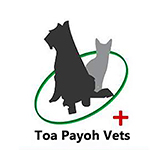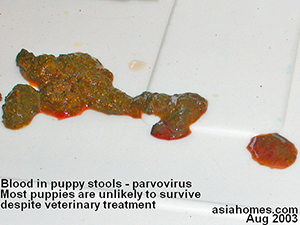 TOA
PAYOH VETS PTE LTD TOA
PAYOH VETS PTE LTDtoapayohvets.com Blk 1002, Toa Payoh Lor 8, 01-1477,
Singapore 319074. Tel: +65
6254-3326,
9668-6468,
judy@toapayohvets.com,
99pups@gmail.com |
|
PARVOVIRAL INFECTION AND FALSE PREGNANCY - TWO CASE STUDIES IN 2003 |
|
Case 1. Parvovirus. The
Golden Retriever puppy shot fresh blood
Puppies should have been vaccinated
before they were exported to Singapore. The Singapore Agri-Food and
Veterinary Authority prohibited the import of puppies younger than twelve
weeks old and they must be vaccinated against distemper and parvoviral
infections at least twice. |
|
Case 2. False Pregnancy. Show and tell. A drop of milk is worth a thousand words "Is this a new breed of Dachshund? She is very small in size." I asked Mrs Soh who brought in a small dog with short legs and a long body, about the length of the Singapore phone book. She was about the size of the bigger tom cats seen in Singapore. She had an appointment for spaying and had starved the bitch for the past twelve hours with no food or water. Although I did not ask Mrs Soh whether the bitch had been mated, I presume that she was not as most young working Singaporean couples living in apartments do not breed dogs. The bitch had unusually large nipples. Changes in the size of the nipples are usually the result of pregnancy and this bitch looked as if it had been pregnant in the last four weeks. Mrs Soh was shocked. "This is a cross bred Dachshund. She is around one-year old. She can never be pregnant as she was at home all the time." If the bitch had not been naughty and definitely had no encounters with a male dog, how could she be pregnant? This must be what most Owners would think. I showed Mrs Soh the slightly enlarged breasts and all the larger than normal nipples. The vulva lips were also larger than normal indicating a recent heat. Since Mrs Soh had not seen other bitches and this is the first time she had a dog, the sizes of the bitch's female reproductive system did not make an impression. She must have thought that I had mis-diagnosed a pregnancy. I palpated the mammary tissues and pressed up from the base of the tissues. A barely visible drop of light yellow milk oozed out from the front nipple. Milk production must have been shutting down, otherwise there would be a stronger squirt. Mrs Soh saw the milk but not her husband who came into the consultation room a few minutes later. Only one drop and no more. From only one nipple. It was the ending stage of false pregnancy. I prefer not to spay a bitch with false pregnancy as some milk from the breast tissues may be incised when I operated. Milk will then leak into the operating area and worse of all, into the abdomen and cause peritonitis and infection. "Can you wait another two weeks before surgery so that the milk production would have stopped completely?" I asked Mrs Soh. It would be Chinese New Year and it would be difficult to care for the bitch after surgery during the festive week with so many visitors coming to visit the Soh family. She may have to take leave from work to bring the bitch in again. Dachshunds are famous for having false pregnancies but not all of them will suffer from this medical condition. The cause would be an abnormal hormonal system. Since the bitch was healthy and milk production had almost ended, I decided to spay her. I gave her a tranquiliser and then gas anaesthetic. She slept well during anaesthesia. Her uterus or womb was considerably enlarged, about ten times bigger than a bitch without a false pregnancy condition. Although Mrs Soh was referred by her friend to me, she was a first-time client and trust had to be earned. Fortunately for me there was milk production. The very last drop to substantiate a diagnosis of false pregnancy. Seeing a drop of milk is worth a thousand words as the vet "must show, not tell'. |
|
|
|
|

